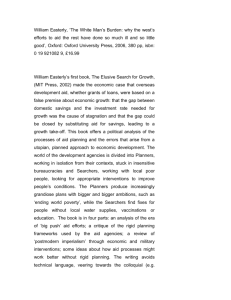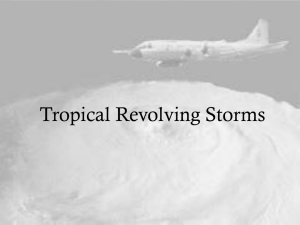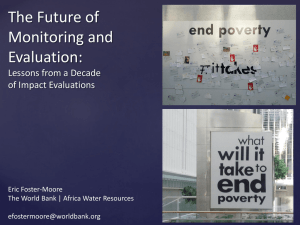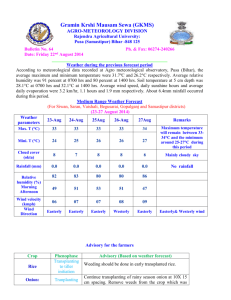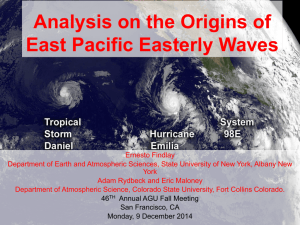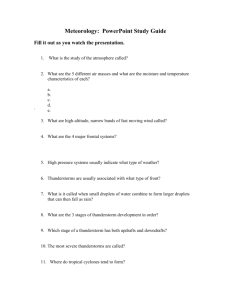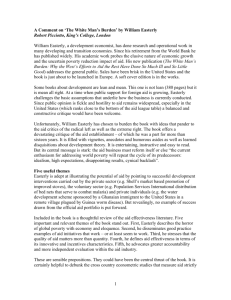Notes and Correspondence Western North Pacific than in the North Atlantic?
advertisement
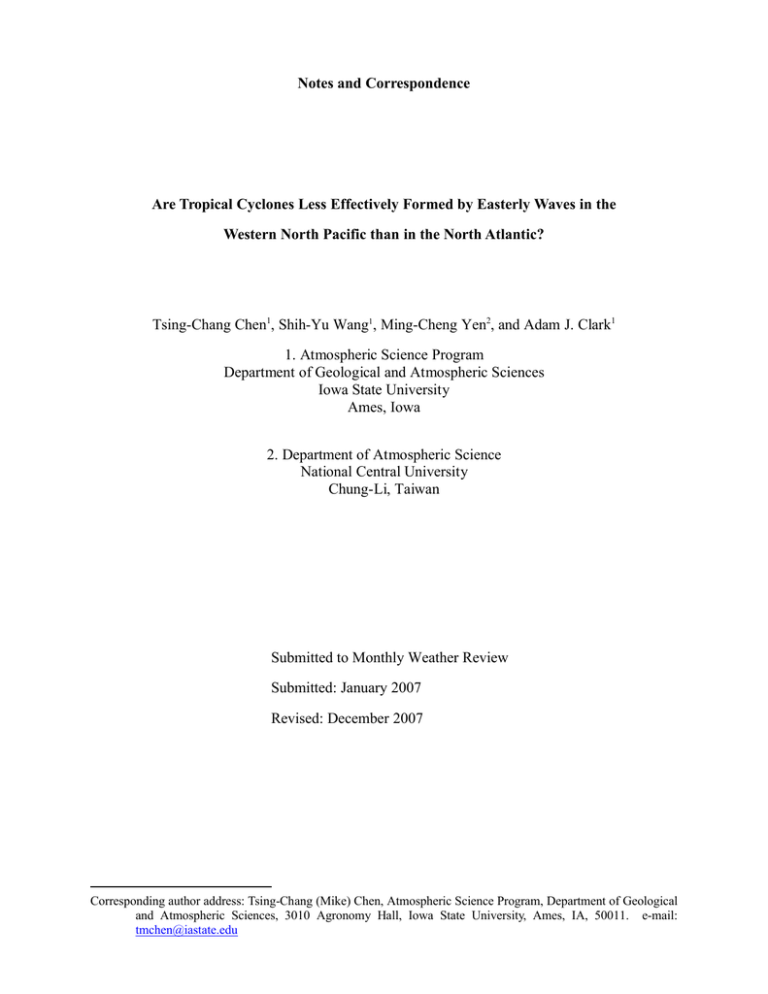
Notes and Correspondence Are Tropical Cyclones Less Effectively Formed by Easterly Waves in the Western North Pacific than in the North Atlantic? Tsing-Chang Chen1, Shih-Yu Wang1, Ming-Cheng Yen2, and Adam J. Clark1 1. Atmospheric Science Program Department of Geological and Atmospheric Sciences Iowa State University Ames, Iowa 2. Department of Atmospheric Science National Central University Chung-Li, Taiwan Submitted to Monthly Weather Review Submitted: January 2007 Revised: December 2007 Corresponding author address: Tsing-Chang (Mike) Chen, Atmospheric Science Program, Department of Geological and Atmospheric Sciences, 3010 Agronomy Hall, Iowa State University, Ames, IA, 50011. e-mail: tmchen@iastate.edu Abstract It has been observed that the percentage of tropical cyclones originating from easterly waves is much higher in the North Atlantic (~60%) than in the western North Pacific (10-20%). This disparity between the two ocean basins exists because the majority (71%) of tropical cyclogeneses in the western North Pacific occur in the favorable synoptic environments evolved from monsoon gyres. Because the North Atlantic does not have a monsoon trough similar to the western North Pacific which stimulates monsoon gyre formation, a much larger portion of tropical cyclogeneses than in the western North Pacific are caused directly by easterly waves. This study also analyzed the percentage of easterly waves that form tropical cyclones in the western North Pacific. By carefully separating easterly waves from the lower tropospheric disturbances generated by upper-level vortices that originate from the tropical upper tropospheric trough (TUTT), it is observed that 25% of easterly waves form tropical cyclones in this region. Because TUTT-induced lower tropospheric disturbances often become embedded in the trade easterlies and resemble easterly waves, they have likely been mistakenly identified as easterly waves. Inclusion of these “false” easterly waves in the “true” easterly wave population would result in an underestimation of the percentage of easterly waves that form tropical cyclones, because the TUTT-induced disturbances rarely stimulate tropical cyclogenesis. However, an analysis of monsoon gyre formation mechanisms over the western North Pacific reveals that 82% of monsoon gyres develop through a monsoon trough-easterly wave interaction. Thus, it can be inferred that 58% (= 82% x 71%) of tropical cyclones in this region are an indirect result of easterly waves. Including the percentage of tropical cyclones that form directly from easterly waves (~25%), it is found that tropical cyclones formed directly and indirectly from easterly waves account for over 80% of tropical cyclogeneses in the western North Pacific. This is more than the percentage that has been documented by previous studies in the North Atlantic. 1 1. Introduction It is well known that westward-propagating easterly disturbances in the tropics can be a potential forcing mechanism for tropical cyclogenesis. As documented by Landsea (1993) for the 1967-91 period, approximately 60% of tropical storms, 60% of minor hurricanes, and 80% of intense hurricanes in the North Atlantic evolved from African easterly waves (AEWs). In contrast, tropical cyclogenesis associated with easterly waves in the western North Pacific has been observed to be much less effective. For example, Frank (1988) reported that in the western North Pacific approximately 80% of disturbances that go on to become tropical cyclones form in the monsoon trough and the rest (~10%) develop from easterly waves. Exploring mesoscale aspects of tropical cyclogenesis for 1990-92, Ritchie (1995) showed that 10%-15% of all tropical cyclones formed from easterly waves in this ocean basin. Later, compiling tropical cyclogenesis related to monsoon gyres (Lander 1994) in the western North Pacific, Chen et al. (2004a) found that 25% of geneses originated from easterly waves. The purpose of this study will be to investigate what causes this pronounced disparity in the occurrence frequency of tropical cyclogenesis from easterly waves between the North Atlantic and the western North Pacific. Upper-level vortices resulting from instability of the tropical upper tropospheric trough (TUTT lows, hereafter; Sadler 1976, 1978; Chen et al. 2001) may penetrate to the lower troposphere and become embedded in the trade easterlies, thus, it is likely that they have been mistakenly identified as easterly waves. Because the cold and dry downdraft core of these easterly wave-like disturbances rarely stimulates tropical cyclogenesis, the inclusion of these disturbances in the population of easterly waves over the western North Pacific would lower the apparent effectiveness of easterly waves in generating tropical cyclones. Thus, a careful separation between TUTT lows and easterly waves is also important to diagnose the effectiveness of easterly waves in stimulating tropical cyclogenesis in the western North Pacific. 2 Previous studies (e.g., Lander 1994; Chen et al. 2004a) have shown that monsoon gyres, which often form from a southeast extension of the western North Pacific monsoon trough, play a major role in many tropical cyclogeneses that occur in this region. This large role of monsoon gyres in western North Pacific tropical cyclogeneses likely results in the reduced percentage of tropical cyclones relative to the North Atlantic that are directly stimulated by easterly waves, because the western North Atlantic does not have a monsoon trough like that of the western North Pacific. However, it has been observed (e.g., Holland 1995) that some monsoon gyres form through an interaction between easterly waves and the western North Pacific monsoon trough. Thus, tropical cyclones forming from monsoon gyres stimulated by this interaction are an indirect result of easterly waves. To fully diagnose the effectiveness of easterly waves in stimulating tropical cyclogeneses and to compare the effectiveness to that of the North Atlantic, tropical cyclones in the western North Pacific forming both directly and indirectly from easterly waves should be considered. In view of tropical cyclogeneses directly linked to easterly waves, the potential impact of TUTT lows on the easterly wave population, and tropical cyclogeneses indirectly associated with easterly waves through monsoon gyres, this study aims to clarify the effectiveness of easterly waves in tropical cyclogenesis over the western North Pacific relative to the North Atlantic, and is organized as follows: In Section 2, data sources and procedures are presented. In Section 3, the differences in the large-scale summer circulation between the North Atlantic and western North Pacific Ocean basins, as well as the potential impact of misidentified TUTT lows on the easterly wave population are considered. Also in Section 3, the formation of monsoon gyres and the effect of monsoon gyres on tropical cyclogeneses are analyzed. Subsequently, the numbers of tropical cyclones that form directly and indirectly from easterly 3 waves are determined. Concluding remarks and a summary are provided in Section 4. 2. Data and procedures During the period of 1979-2002, the 6-hr ERA-40 reanalyses (Källberg et al. 2004) and the best-track records issued by the Joint Typhoon Warning Center (JTWC in Hawaii; JTWC 1991 and Chu et al. 2002) are used for the circulation depiction and tropical cyclone/depression track analyses, respectively. Infrared (IR) images shown in Fig. 1 were derived from Geostationary Meteorological Satellite (GMS) observations from the Japan Meteorological Agency (JMA). Using ERA-40 horizontal wind and vertical motion, easterly perturbations in the western North Pacific were tracked and classified into two types: conventional easterly wave (e.g. Reed and Recker 1971) and easterly disturbance generated by the downward penetration of a TUTT low. These perturbations were identified in terms of the low-level flow patterns and categorized through their upper-level structure using three steps: 1) Identification: A clear cyclonic perturbation or an open trough embedded in the tropical easterlies in the 850mb streamline charts must have a life cycle longer than 3 days. 2) Classification: A conventional easterly wave is identified if this perturbation occurs below an upper-level anticyclonic circulation. An easterly wave-like disturbance is induced by the downward penetration of a TUTT low and overlaid by a well-defined closed vortex of TUTT low in the 200-mb streamline charts. 3) Verification: Grid-scale upward motion in the ERA-40 reanalyses appears west (east) of the trough of the identified easterly wave (TUTT low-induced easterly disturbance) for more than half of this perturbation’s life cycle. Thus, the easterly wave/disturbance is coupled with an east-west circulation (as indicated by thick shafted green line in Fig. 2 and will be discussed later). Upward motion induced by easterly disturbances is also verified by GMS IR images as shown in Fig. 1. The life cycle of a perturbation is defined in terms of 850-mb vorticity. The mature stage of an easterly wave is defined as the period when the maximum vorticity of this wave reaches 4 1.5x10-5s-1 and is coupled with a well-organized east-west circulation. In addition to the eastwest circulation, the mature phase of the TUTT low-induced easterly disturbance is defined when the vorticity of this disturbance reaches 10-5s-1. To identify the origin of individual easterly waves, a backtracking approach was adopted. When a tropical cyclone that formed from an easterly wave was identified, the easterly wave was tracked backwards until the wave was no longer detectable. In this approach, the easterly waves were detected using 850-mb streamlines superimposed with 850-mb vorticity, ∆OLR (≡235Wm2−OLR), ω(500mb) vertical motion, and available infrared satellite images from the JMA Geostationary Meteorological Satellite. As previously pointed out, to fully diagnose the effectiveness of easterly waves in stimulating tropical cyclogenesis, tropical cyclones forming indirectly from easterly waves through monsoon gyres must be considered (Chen et al. 2004a). This requires a careful analysis of different monsoon gyre formation mechanisms and a determination of the percentage of monsoon gyres formed through some type of easterly waves/monsoon trough interaction. To accomplish this analysis, monsoon gyres (MGs) are identified in terms of the following criteria: 1) Closed cyclonic streamlines, with an east-west dimension of 1,500-3,000 km and a life cycle of 5 days−3 weeks, appear prior to or during tropical cyclogenesis. 2) Intense upward motion exists over the confluence region east of the gyre, while broader weak downward motion covers the rest of the gyre west of the confluence region. 3) The vertical structure of streamfunction in the short-wave (waves 3-15) regime containing the MG exhibits a vertical phase reversal with a cyclonic cell in the lower troposphere and an anticyclonic cell in the upper troposphere. 4) At least one tropical cyclogenesis occurs along the southeast-east periphery of the gyre. Note that Criteria 1 and 4 are not as restrictive as those used in some past studies (e.g. Lander 1994; Chen et al. 2004a). For example, Holland (1995) pointed out that the MG life cycle can be as short as five days and is involved with only one tropical cyclogenesis. However, Criteria 2 and 3 imposed here make it nearly impossible for other types of cyclonic disturbances (e.g. tropical depressions) to be classified as MGs. 5 3. Formation of tropical cyclones related to easterly waves 3.1 Summer circulation Vorticity and large scale ascent within the environmental flow are crucial factors in tropical cyclogenesis (Gray 1978). Thus, significant differences in the large-scale summer environmental flows between the two ocean basins may affect the effectiveness of easterly waves in tropical cyclogenesis. The most relevant features of the summer circulation are highlighted below: 1) The Asian monsoon consists of the Tibetan high and the Indian monsoon trough, while the North American monsoon includes the Mexican high and the North American continental thermal low. These circulation features are basically formed by the wavenumber-1 and -2 components along longitudinal circles. The vertical structure of the wavenumber-1 component is in phase with the Asian monsoon, but out of phase with the North American monsoon (Chen 2003). Because of this vertical phase relationship between the wavenumber1 component and the two monsoons, the development of the North American monsoon is limited by this wave, which may explain its very limited role in North Atlantic tropical cyclogenesis. The difference in intensity and scale of these two monsoons is also reflected by the existence of the upper-level oceanic trough and the low-level monsoon trough in the western tropical Pacific formed by the strong monsoon westerlies and the trade easterlies of the North Pacific anticyclone. These circulation features are formed primarily by the wavenumber-1 and -2 components which are spatially in quadrature in the North Pacific, but out of phase in the North Atlantic (Krishnamurti 1971). The equatorial side of the upper-level oceanic trough is a breeding region for TUTT lows which may generate “false” easterly waves (Chen et al. 2001), while large vorticity along the monsoon trough facilitates tropical cyclogenesis (Gray 1978). 2) The large-scale east-west differential heating between the warming caused by latent heat released from cumulus convection over the Asian monsoon region and radiative cooling in the upper troposphere over North Africa maintains a planetary-scale east-west circulation with a 6 strong and extensive upward branch over the western tropical Pacific. A similar regionalscale east-west differential heating between warming over the western tropical AtlanticCaribbean Sea region and cooling over the eastern tropical Pacific forms a smaller-scale and less intense east-west circulation with the upward branch over the former region. A factor conducive to tropical cyclogenesis is upward motion generated by the large-scale circulation (Zehr 1992). The intensity difference between these two east-west circulations should affect the occurrence frequency of tropical cyclogenesis in the western tropical regions of the two ocean basins. 3.2 Effect of TUTT lows The formation of TUTT lows by the instability of the North Pacific oceanic trough often induces a low-level vortex with a descending cold core from the convergence of upper-level cold air. The downward penetration of a cold-core vortex may be weakened by the lower- tropospheric North Pacific anticyclone and often no signal of the cold-core vortex is detected in the lower troposphere. It was observed by Chen et al. (2001) that one third of TUTT lows in the North Pacific may drift across 15oN to the tropics (Fig. 1a) and penetrate down to the lower troposphere (Fig. 1c) to form low-level disturbances (Fig. 1b) along the southern periphery of the North Pacific anticyclone. The spatial structure of these disturbances in the lower troposphere resembles easterly waves (Fig. 1e). If these TUTT low-induced easterly disturbances are mistakenly identified as easterly waves, the population of easterly waves would be overestimated. In fact, the characteristics of TUTT low-induced easterly disturbances differ from easterly waves in many ways. To distinguish these two types of low-level disturbances, some differences in their basic characteristics revealed from Fig. 1 are highlighted: (1) Vertical Structure: It is revealed from Figs. 1a and b that the TUTT low-induced easterly disturbance occurs below an upper-level cyclonic vortex. The vertically uniform structure of a TUTT low emerges from the east-west cross-section of the eddy component of geopotential height Z E (15 o N) (Fig. 1c). In contrast, a low-level easterly wave (Fig. 1e) 7 occurs below an upper-level anticyclonic vortex (Fig. 1d). A vertical phase reversal of the easterly wave can be inferred from the contrast between the upper- and lower-level flows shown in Figs. 1d and e, respectively. This vertical phase change in an easterly wave is confirmed by the east-west cross-section of Z E (12.5 o N) (Fig. 1f). (2) Cumulus convection/east-west circulation: Cumulus clouds appear east of (behind) the trough line of the TUTT low-induced easterly disturbance (Fig. 1b), but exist west of (ahead) the trough line of the easterly wave (Fig. 1e). Cumulus convection is maintained by upward motion. Based on the spatial relationship between cumulus clouds and trough lines, it is expected that upward motion generated by TUTT low-induced easterly disturbances and easterly waves is opposite in location with respect to their trough lines. Dynamically, the surface divergence generated by the cold-core downdraft of TUTT lows is blocked by the environmental airmass to produce upward motion around the periphery of these upper-level lows. In contrast, the east-west circulation of easterly waves is maintained by the vertical motion induced by the differentiation of vorticity advection. To substantiate our inference, the maximum and minimum ω (500mb) values of easterly disturbances/waves along the abscissa in Fig. 2 and their distance from the trough line along the ordinate during the mature stage (defined in Section 2) are plotted in scatter diagrams (Fig. 2); upward (downward) motion is denoted by red dots (blue triangles). The schematic east-west circulations coupled with these two types of easterly disturbances are also added in this figure. It was pointed out that convective clouds appear east of the trough line of TUTT low-induced easterly disturbances (as the east half of Fig. 2a) and sometimes stratus clouds may encircle the TUTT low [as indicated by the distribution of ω (500mb) in Fig. 2a and the superimposed east-west circulation]. In contrast, upward (downward) motion in a mature easterly wave concentrates west (east) of the wave’s trough line (Fig. 2b). (3) Tropical cyclogenesis As pointed out in Item (2), upward motion around the periphery of a TUTT low may 8 facilitate TC/TD formation. The genesis of Typhoon Cary (July 5, 1984) will be used as an example to illustrate this possibility. The three-dimensional structure of the TUTT low associated with this typhoon is shown in Fig. 3. Convective clouds around the eastnortheast periphery of the TUTT low are revealed from ∆OLR (≡ 235 Wm-2-OLR) (Fig. 3a). The east-west cross-section of the TUTT low indicated by vorticity ζ(15oN) (Fig. 3b) is superimposed with vertical motion ω . The downdraft core of the TUTT low is surrounded by the updraft. An easterly wave-like disturbance overlaid by the vortex of this TUTT low is apparent from the 850-mb streamline chart (Fig. 3c). During the 24 year period of 19792002, it was found that only 9 TCs/TDs formed from TUTT lows as Typhoon Cary contributing to only 1.9% of the TC/TD geneses analyzed in this study. Thus, it is possible for a TUTT low to stimulate tropical cyclogenesis, but this rarely occurs. (4) Daily locations Daily locations of easterly waves (blue dots) and TUTT low-induced easterly disturbances (red dots) for all identified cases, superimposed on 200- and 850-mb summer-mean streamline charts, are shown in Fig. 4a and b, respectively. Locations of the latter disturbances are restricted to within the North Pacific west of approximately 150oW, while some of the easterly waves can be traced to the eastern tropical Pacific and West Africa [not shown, because residual disturbances of AEWs contribute to only 7% of the population of easterly waves]. The mean latitudes of easterly waves and TUTT-induced easterly disturbances west of 150oW are at 7.5oN and 17.5oN, respectively. As inferred from streamlines at both levels, these tropical weather disturbances are transported westward by easterlies. Trajectories of easterly waves are usually located further south of the North Pacific oceanic trough than the TUTT low-induced easterly disturbances. The average population of easterly waves during summer (MJJAS) for the period of 19792002 is 18.4, while that of TUTT low-induced easterly disturbances is 8.8. Thus, the population of easterly perturbations in the western tropical Pacific (27.2 per summer) contributed to by the former is 67% and by the latter is 33%, respectively. Regardless of distinctive features between 9 easterly waves and TUTT low-induced easterly disturbances depicted above, the latter perturbations may be included in the population of the former, because of their similar spatial structure in the lower troposphere (shown in Figs. 1b and e). Consequently, the population of easterly waves in the western tropical Pacific is overestimated by including TUTT low-induced easterly disturbances. Approximately 25% of easterly waves formed tropical cyclones in the western North Pacific (the South China Sea is not included) for the 1979-2002 period. If the population of TUTT low-induced easterly disturbances is mistakenly included in easterly waves, the percentage of easterly waves forming tropical cyclones in the western North Pacific would be reduced to slightly below 17%. 3.3 Formation and effect of monsoon gyres From the analysis of monsoon gyres linked to tropical cyclones over the study period, it was found that all monsoon gyres generally form through one of four common large-scale flow patterns, two of which involve easterly waves. Different phases in the evolution of these four patterns are described using 850-mb streamline and vorticity charts for examples of individual cases corresponding to each flow type (Fig. 5). 1) Easterly waves (Type 1— merging case; Fig. 5a) The formation of a MG coupled with an easterly wave is depicted in terms of four different synoptic steps for a case that occurred on 8-13 August 2001 (Fig. 5a). Step 1: The South/Southeast Asian monsoon circulation is characterized by a subtropical monsoon trough juxtaposed meridionally with an equatorial anticyclone which is separated from the trough by the monsoon westerlies. Over the western tropical Pacific, the flow along the southern rim of the North Pacific anticyclone is driven by the trade easterlies. An easterly wave (indicated by thick-dashed line in the top panel in Fig. 4a) is embedded in the trade easterlies at 0000 UTC 8 August 2001. This disturbance is trailed by a weak anticyclonic perturbation to the east and also accompanied by another anticyclonic perturbation to the west forming a synoptic-scale short-wave train, as depicted by previous studies (e.g. Liebmann and Hendon 1990, Takayabu and Nitta 10 1993). The northwestward propagation of the cyclonic disturbance in the wave train follows the northward progression of the monsoon trough (explained below). Step 2: The anticyclonic perturbation west of the easterly wave dissipates and merges with the equatorial anticyclone, while the easterly wave reaches the monsoon trough one day later on 9 August 2001. The easterly wave eventually merges with the monsoon trough, extending the trough eastward beyond 150°E. Step 3: On 10 August, the anticyclonic perturbation east of the monsoon trough is trailed by a new easterly wave located near 160°E. One day later on 11 August 2001, this anticyclonic perturbation became well-organized and was juxtaposed between the monsoon trough (with a developing MG on its east tail) and the easterly wave (not shown). The amplifying anticyclonic perturbation connects the equatorial anticyclone and the North Pacific anticyclone. Step 4: By 1200 UTC 13 August 2001, a MG on the east end of the monsoon trough had formed. A slow northward progression of this monsoon trough/gyre was ongoing as a new shortwave train composed of the anticyclonic perturbation east of the MG and the new easterly wave propagated northwestward (as reported by Liebmann and Hendon 1990, and Takayabu and Nitta 1993). As expected by wave accumulation theory (Sobel and Bretherton 1999), the interaction between this MG and this new short-wave train formed in Step 3 eventually led to the genesis of Typhoon Pabuk. 2) Easterly waves (Type 2— self-development case; Fig. 5b) Initially, the northwestward propagating easterly wave is embedded in a synoptic-scale short-wave train and juxtaposed with anticyclonic perturbations to the west and east (Step 1). The wave accumulation caused by the westward propagation of the easterly wave does not amplify this disturbance, rather, the disturbance decays and tilts northwestward. The western anticyclonic perturbation does not dissipate as in Step 2 of the Type-1 formation process, but eventually merges with the equatorial anticyclone (Step 2). The easterly wave grows to form a synoptic vortex, in accompany with the amplification of the eastern anticyclonic perturbation which became part of the equatorial anticyclone (Step 3). Eventually, a MG formed from the 11 synoptic vortex around 1200 UTC 15 September 1986, about 3 days before the genesis of Typhoon Abby at 0000 UTC 9 September 1986 (Step 4). 3) Midlatitude trough (Fig. 5c) The MG of July-August 1991 discussed in Lander (1994) illustrates the southward intrusion of a midlatitude trough in the North Pacific and the subsequent formation of a MG. For the corresponding synoptic development at upper levels, one may consult Lander (1994). Step 1: The low-level North Pacific anticyclone was divided by the equatorward intrusion of a midlatitude trough into two anticyclonic cells that followed the eastward propagation of the upper level East-Asian anticyclone into the North Pacific (not shown). The eastward extension of the upper-level anticyclone was separated from the East-Asian high by a midlatitude trough, like the low-level anticyclone. Step 2: Over only six hours (from 18Z on July 31 to 00Z on August 1, 1991), the low-level western North Pacific anticyclone retreated slightly westward, while the midlatitude trough deepened further forming a cutoff low. This newly developed low was overlaid by the eastward extension of the upper-level anticyclone (not shown). Thus, a monsoonlike vertical structure with a phase reversal started to appear. Step 3: The cutoff low eventually separated from the midlatitude trough and formed a MG. 4) Monsoon trough (Fig. 5d) The monsoon trough with intensified monsoon westerlies along its southern rim extends east to the Dateline (step 1; August 8, 1981). The strong shear flow across this trough is perturbed by easterly waves forming multiple closed lows within the trough (step 2). Later, the monsoon trough became SW-NE oriented, like Lander’s (1996) reverse-oriented monsoon trough. These closed lows within the trough developed into MGs and led to geneses of Typhoons Vanessa, Thad, and Bill (step 3; August 11, 1981). The formation process of MGs in this flow pattern is similar to that of the Type-1 easterly wave, except for the eastward extension of the monsoon trough and intensified monsoon westerlies. To facilitate a statistical analysis of MG formation mechanisms using the previously mentioned criteria, schematic diagrams of the basic synoptic flow patterns discussed in the 12 previous four examples are presented in Fig. 6. It is found that the Type-1 and Type-2 MG formation mechanisms, which involve easterly waves, contribute to 54% and 28% of identified gyres, respectively (Fig. 7). Populations of MGs formed by midlatitude troughs and perturbed monsoon troughs are 13% and 5%, respectively. Although Type-3 MGs [similar to Lander (1994)] can be prolific generators of tropical cyclones, their low occurrence frequency results in a relatively small contribution to the total number of tropical cyclogeneses along with the Type-4 MGs. The majority (82%) of MGs form through the interaction between easterly waves and the monsoon trough (Types 1 and 2) and 71% of tropical cyclogeneses are linked to MGs in the western tropical Pacific (Chen et al. 2004). It can be easily inferred that approximately 58% (=82%x71%) of tropical cyclogenesis in this region are an indirect result of easterly waves. 3.4 Impact of Easterly waves The geographic locations of tropical cyclones formed directly by easterly waves (blue tropical cyclone symbol) and indirectly by easterly waves through their stimulation of monsoon gyres (red tropical cyclone symbol) with the seasonal-mean 850-mb streamline are shown in Fig. 8a. The monsoon gyre-related tropical cyclogeneses are concentrated over the monsoon trough while those formed directly from easterly waves and TUTT low-induced easterly disturbances are scattered over the western tropical-subtropical Pacific. The percentage of tropical cyclogeneses induced directly by easterly waves is 25% and indirectly through monsoon gyres is 58%. Thus, the total contribution of easterly to tropical cyclone formation in the western North Pacific is approximately 83% (=58+25%). TUTT lows and other processes combined contribute to only 4% of tropical cyclogeneses (Fig. 8b). Recall that the western tropical Atlantic does not have a monsoon trough like the western tropical Pacific. Thus, most hurricanes are formed directly from AEWs (Landsea 1993). Because of the existence of an extended monsoon trough and its interaction with monsoon westerlies and trade easterlies, the role played by easterly waves in the tropical cyclogenesis over the western tropical Pacific is different from that over the tropical Atlantic. Tropical cyclones 13 are directly formed from easterly waves more often in the North Atlantic than in the North Pacific. On the other hand, tropical cyclogenesis in the western North Pacific can be accomplished indirectly by easterly waves through the formation/development of monsoon gyres which are either stimulated by these easterly perturbations or grown directly from the easterly waves. Evidently, easterly waves in the western North Pacific are not less effective in forming tropical cyclones than easterly waves in the tropical Atlantic if this formation through the stimulation of monsoon gyres is considered. The contribution to tropical cyclogenesis by easterly waves in the western North Pacific that stimulate monsoon gyres, which in turn lead to tropical cyclogenesis, has not been considered in past studies. Because of an understanding of the role of AEWs in tropical cyclogenesis in the North Atlantic [the majority of tropical cyclones in the North Atlantic evolve from AEWs (Landsea 1993)], as well as the preferred genesis region for AEWs [south of the African easterly jet (Burpee 1972) and over the Saharan thermal low north of the African easterly jet (Chen 2006)], the National Hurricane Center rigorously tracks AEWs from their genesis locations during the hurricane season. In the western North Pacific, however, the weather services in this region (e.g. JTWC, JMA, and other agencies) have not operationally tracked easterly waves, which is likely because the indirect role easterly waves have in the majority of tropical cyclones has not been recognized in the past. In addition, plots of genesis locations of easterly waves (Figs 4c and d) linked directly (solid blue circles) and indirectly (solid red triangles) to tropical cyclogeneses in the western North Pacific do not show a preferred genesis region, which may be caused by the large east-west extent of barotropic instability in the Pacific trader easterlies that may lead to a majority of easterly wave geneses (Yanai and Nitta 1968; Nitta and Yanai 1969). Note that a small portion (~7%) of tropical Pacific easterly waves actually originated as AEWs which are generated by Charney-Stern instability (Burpee 1972) and Chang-Thorncroft instability (Chen 2006) over north and west Africa. The lack of a preferred genesis region would likely make it difficult, if not impossible, to operationally track easterly waves in the tropical Pacific, like the AEWs in the North Atlnatic. 14 4. Concluding remarks This study explored whether tropical cyclones formed by easterly waves in the western North Pacific occur less frequently than in the western North Atlantic, as observed by previous studies (Frank 1988, Ritchie 1995, Chen et al. 2004a). A majority of tropical cyclones in the western North Pacific are formed directly by easterly waves and indirectly by easterly waves that stimulate monsoon gyre formation providing a favorable breeding region for tropical cyclones. Both formation mechanisms are related to special features of the North Pacific summer circulation: (1) From a planetary-scale perspective, the zonal wavenumber-1 and -2 components of the summer circulation are spatially in quadrature over the North Pacific, but out of phase over the North Atlantic. Because of the spatial relationship between these two wave components, intensities of the upper-level oceanic trough and the low-level anticyclone over the North Pacific are stronger in the North Pacific than the North Atlantic. (2) In the lower troposphere, a monsoon trough is formed over the southeast Asia-western tropical Pacific region by the strong monsoon westerlies in South Asia and the trade easterlies of the North Pacific anticyclone. The North Pacific summer circulation provides a favorable environment for TUTT lows that form along the equatorial side of an oceanic trough. These upper-level vortices can resemble easterly waves when they penetrate to lower levels and become embedded in the trade easterlies. A careful separation of easterly waves and lower tropospheric disturbances generated by these upper-level vortices reveals that about 25% of western North Pacific easterly waves form tropical cyclones, a number that would have been reduced to 17% if the lower tropospheric disturbances generated by the upper-vortices were included in the easterly wave count. On the other hand, the two elements of the North Pacific summer circulation form a favorable environment for monsoon gyres of which approximately 82% form through monsoon trough/easterly wave interaction. Without the existence of a monsoon trough in the tropical 15 Atlantic, tropical cyclones formed directly from easterly waves occur more frequently in the North Atlantic than in the western North Pacific. However, because 71% of tropical cyclogeneses have been observed to be related to monsoon gyres and 82% of monsoon gyres are formed through an interaction with easterly waves, it can be inferred that tropical cyclones indirectly formed by easterly waves contribute to about 58% (= 71% x 82%) of tropical cyclones in the western North Pacific. Including the percentage of tropical cyclones that form directly (~25%) and indirectly (~58%) from easterly waves, over 80% of tropical cyclogeneses in the western North Pacific are the direct or indirect result of easterly waves. Acknowledgments Part of this paper was done during T.-C. Chen’s visit to National Central University (NCU) in Taiwan. This visit was partially supported by the NCU Development Program for Top-Ranked University sponsored by the Ministry of Education in Taiwan, Grants NSC95-2811M-008-09 and NSC95-2111-M-008-007. The effort of M.-C. Yen was supported by Grants NSC95-2111-M-008-016-MY3 and NSC95-2625-008-002. Comments offered by Dr. Chris Landsea of National Hurricane Center and two anonymous reviewers are helpful in improving this paper. 16 References Burpee, R. W., 1972: The origin and structure of easterly waves in the lower troposphere of North Africa. J. Atmos. Sci., 29, 77-90. Chen, T.-C., 2003: Maintenance of summer monsoon circulations: A planetary-scale perspective. J. Climate, 16, 2022–2037. ____, 2006: Characteristics of African Easterly Waves Depicted by ECMWF Reanalyses for 1991-2000. Mon. Wea. Rev., 12,3539-3566 ____, S.-Y. Wang, M.-C. Yen and W. A. Gallus Jr., 2004a: Role of the monsoon gyre in the interannual variation of tropical cyclone formation over the western North Pacific. Wea. Forecasting, 19, 776–785. ____, ____, W.-R. Huang and M.-C. Yen, 2004b: Variation of the East Asian summer monsoon rainfall. J. Climate, 17, 744–762. ____, M.-C. Yen, G.-R. Liu and S.-Y. Wang, 2001: Summer upper–level vortex over the North Pacific. Bull. Amer. Meteor. Soc., 82, 1991–2006. Chu, J.-H., E. Fukada, and Sampson C. R., 2002: The Joint Typhoon Warning Center Tropical Cyclone Best-Tracks, 1945-2000. JTWC Report, NRL Reference Number: NRL/MR/ 7540-02-16, available online at JTWC URL: https://metocph.nmci.navy.mil/jtwc/best_tracks/TC_bt_report.html. Frank, W. M., 1988: Tropical cyclone formation. A Global View of Tropical Cyclones, R. L. Elsberry, Ed., Office of Naval Research, 53-90. Gray, W. M., 1978: Hurricanes: Their formation, structure and likely role in the tropical circulation. Meteorology over the Tropical Oceans, D. B. Shaw, Ed., Royal Meteorological Society, 127–139. Holland, G. J., 1995: Scale interaction in the western Pacific monsoon. Meteor. Atmos. Phys., 56, 57-79. JTWC (Joint Typhoon Warning Center), 1991: Annual Tropical Cyclone Report. NAVOCEANCOMCEN/ JTWC, COMNAVMAR, PSC 489, BOX 12, FPO AP 9654017 0051. 238 pp. Källberg, P., A. Simmons, S. Uppala, and M. Fuentes, 2004: The ERA-40 archive. ERA-40 Project Report Series No. 17 (available online at http://www.ecmwf.int/publications/). Krishnamurti, T. N., 1971: Observational study of the tropical upper tropospheric motion field during the Northern Hemisphere summer. J. Appl. Meteor., 10, 1066–1096. Lander, M. A., 1994: Description of a monsoon gyre and its effects on the tropical cyclones in the western North Pacific during August 1991. Wea. Forecasting, 9, 640–654. ____, 1996: Specific tropical cyclone track types and unusual tropical cyclone motions associated with a reverse-oriented monsoon trough in the western North Pacific. Wea. Forecasting, 11, 170–186. Landsea, C. W., 1993: A climatology of intense (or major) Atlantic hurricanes. Mon. Wea. Rev., 121, 1703–1713. Liebmann, B., and H. H. Hendon, 1990: Synoptic-scale disturbances near the Equator. J. Atmos. Sci., 47, 1463-1479. Nitta, T. and M. Yanai, 1969: A note on the barotropic instability of the tropical easterly current. J. Meteor. Soc. Japan. 47, 127-130. Ramage, C. S., 1952: Variation of rainfall over south China through the wet season. Bull. Amer. Meteor. Soc., 33, 308-311. Reed, R. J., and E. E. Recker, 1971: Structure and properties of synoptic-scale wave disturbances in the equatorial western Pacific. J. Atmos. Sci., 28, 1117-1133. Ritchie, E. A., 1995: Mesoscale aspects of tropical cyclone formation. Ph.D. dissertation, Centre for Dynamical Meteorology and Oceanography, Monash University, Melbourne, VIC 3168, Australia, 167 pp. Sadler, J. C., 1976: A Role of the Tropical Upper Tropospheric Trough in Early Season Typhoon Development, Mon. Wea. Rev., 104, 1266–1278. ____, J. C., 1978: Mid-Season Typhoon Development and Intensity Changes and the Tropical Upper Tropospheric Trough. Mon. Wea. Rev, 106, 1137–1152. 18 Sobel, A. H., and C. S. Bretherton, 1999: Development of synoptic-scale disturbances over the summertime tropical Northwest Pacific. J. Atmos. Sci., 56, 3106-3127. Takayabu, Y. N., and T. Nitta, 1993: 3-5 day disturbances coupled with convection over the tropical Pacific Ocean. J. Meteor. Soc. Japan, 71, 221-245. Yanai, M. and T. Nitta, 1968: Finite difference approximations for the barotropic instability problem. J. Meteor. Soc. Japan, 46, 389-403. Zehr, R. M., 1992: Tropical cyclogenesis in the western North Pacific. NOAA Tech. Rep. NESDIS 61, 181 pp. [Available from U.S. Department of Commerce, NOAA/NESDIS, 5200 Auth Rd., Washington, DC 20233] 19 Figure Captions Fig. 1 Contrast of spatial structure between the tropical upper tropospheric trough (TUTT) loweasterly disturbance generated by the downward penetration of the TUTT low (left column) and a conventional easterly wave (right column): GMS satellite imagery at 0000 UTC on 18 June 2000 superimposed with a) 200mb streamlines and b) 850mb streamlines, c) and east-west vertical cross-section of the eddy component of geopotential height at 15°N latitude, and (d)-(f) same as (a)-(c), except for a convectional easterly wave. Fig. 2 Scatter diagrams of maximum (red dots) and minimum (blue triangles) ω(500mb) vs. its distance away from the trough line which is determined by 850mb streamline charts as shown in Figs. 1b and 1e for (a) TUTT low-induced easterly disturbances, and (b) conventional easterly waves. A schematic east-west circulation associated with both TUTT low-induced easterly disturbances in (a) and easterly waves in (b) are depicted by the green line with shaft. ω(500mb) is used when the vorticity (ζ) along the trough line of an easterly disturbance/wave reaches its maximum (above 10-5s-1) over its lifetime. Fig. 3 Three-dimensional structure of TUTT low and the lower-tropospheric easterly disturbance induced by this TUTT low on July 5, 1984 when the genesis of Typhoon Cary occurred: (a) 200-mb streamlines superimposed with ∆OLR (≡ 235 Wm-2 -OLR), (b) east-west cross-section of (ζ, ω)(15oN), and (c) same as (a) except for 850-mb streamlines. The genesis location (red typhoon symbol) is indicated in (c). ζ and ω are relative vorticity (solid lines) and dp/dt (color areas; p=pressure, ω vertical motion). The contour interval of ζ is 0.5×10-5s-1. Magnitude scales of OLR and ω are shown in the lower right of (a, c) and (b), respectively. Fig. 4 Daily locations of TUTT low-induced easterly disturbances (red dots) and easterly waves (blue dots) superimposed on the seasonal-mean streamlines at (a) 200mb and (b) 850mb, and (c) and (d), same as (a) and (b), respectively, except genesis locations of easterly waves and TUTT low-induced easterly disturbances. Genesis locations of easterly waves directly and indirectly linked to tropical cyclogenesis are marked by solid-blue dots and 20 solid-red squares, respectively, while TUTT low-induced easterly disturbances linked to tropical cyclogenesis are indicated by golden triangles. Fig. 5 Four different types of synoptic development for monsoon gyre formation portrayed by 850-mb streamlines and vorticity (shading): (a) the trough of Type-1 easterly wave merged with the monsoon trough (8-13 August 2001), (b) the self-amplification of the trough of Type-2 easterly wave (12-19 September 1986), (c) interaction of the equatorward-intruding midlatitude trough with the monsoon trough (31 July–7 August 1991), and (d) deepening of the monsoon trough/intensification of monsoon westerlies (8-17 August 1981). The date of each synoptic step is given in the upper-left corner. Tropical cyclogeneses at the final synoptic step in the monsoon gyre formation are shown by typhoon symbols. Trough lines of easterly waves are marked by dashed lines in (a) and (b). The scale for vorticity is provided at the top right of each column. Fig. 6 Schematic diagrams of streamline portraying the four different types of synoptic development for monsoon gyre formation corresponding to Fig. 5. MT, EW, MG, H, and L are acronyms for monsoon trough, easterly wave, monsoon gyre, anticyclonic and cyclonic perturbations, respectively. Light-gray arrows indicate the transition of steps. Fig. 7 Formation frequencies (NMG) of monsoon gyres by four different types of synoptic developments analyzed during the typhoon season of June-October covering the period of 1979-2002. The percentage contribution from each type is given at the top of each histogram. Fig. 8 (a) Locations of tropical cyclones formed by easterly waves (blue tropical cyclone symbol), monsoon gyres (red tropical cyclone symbol), and TUTT lows (golden tropical cyclone symbol) superimposed on the 850-mb streamline, and (b) histogram of total tropical cyclogeneses linked to monsoon gyres, easterly waves, TUTT lows, and other processes. 21 TUTT-low induced easterly disturbance [V(200mb),IR] [V(200mb),IR] [V(850mb),IR] [V(850mb),IR] Easterly wave Fig. 1 Contrast of spatial structure between the tropical upper tropospheric trough (TUTT) low-easterly disturbance generated by the downward penetration of the TUTT low (left column) and a conventional easterly wave (right column): GMS satellite imagery at 0000 UTC on 18 June 2000 superimposed with a) 200mb streamlines and b) 850mb streamlines, c) and east-west vertical cross-section of the eddy component of geopotential height at 15°N latitude, and (d)-(f) same as (a)-(c), except for a convectional easterly wave. Pa·s-1 Pa·s-1 km (away from trough line) km (away from trough line) Fig. 2 Scatter diagrams of maximum (red dots) and minimum (blue triangles) ω(500mb) vs. its distance away from the trough line which is determined by 850mb streamline charts as shown in Figs. 1b and 1e for (a) TUTT low-induced easterly disturbances, and (b) conventional easterly waves. A schematic east-west circulation associated with both TUTT low-induced easterly disturbances in (a) and easterly waves in (b) are depicted by the green line with shaft. ω(500mb) is used when the vorticity (ζ) along the trough line of an easterly disturbance/wave reaches its maximum (above 10-5s-1) over its lifetime. Fig. 3 Three-dimensional structure of TUTT low and the lower-tropospheric easterly disturbance induced by this TUTT low on July 5, 1984 when the genesis of Typhoon Cary occurred: (a) 200mb streamlines superimposed with ∆OLR (≡ 235 Wm-2-OLR), (b) east-west cross-section of (ζ, ω)(15oN), and (c) same as (a) except for 850-mb streamlines. The genesis location (red typhoon symbol) is indicated in (c). ζ and ω are relative vorticity (solid lines) and dp/dt (color areas; p=pressure, ω vertical motion). The contour interval of ζ is 0.5×10-5s-1. Magnitude scales of OLR and ω are shown in the lower right of (a, c) and (b), respectively. Fig. 4 Daily locations of TUTT low-induced easterly disturbances (red dots) and easterly waves (blue dots) superimposed on the seasonal-mean streamlines at (a) 200mb and (b) 850mb, and (c) and (d), same as (a) and (b), respectively, except genesis locations of easterly waves and TUTT low-induced easterly disturbances. Genesis locations of easterly waves directly and indirectly linked to tropical cyclogenesis are marked by solid-blue dots and solid-red squares, respectively, while TUTT low-induced easterly disturbances linked to tropical cyclogenesis are indicated by golden triangles. (d) Deepening monsoon trough Fig. 5 Four different types of synoptic development for monsoon gyre formation portrayed by 850-mb streamlines and vorticity (shading): (a) the trough of Type-1 easterly wave merged with the monsoon trough (8-13 August 2001), (b) the self-amplification of the trough of Type-2 easterly wave (12-19 September 1986), (c) interaction of the equatorward-intruding midlatitude trough with the monsoon trough (31 July–7 August 1991), and (d) deepening of the monsoon trough/intensification of monsoon westerlies (817 August 1981). The date of each synoptic step is given in the upper-left corner. Tropical cyclogeneses at the final synoptic step in the monsoon gyre formation are shown by typhoon symbols. Trough lines of easterly waves are marked by dashed lines in (a) and (b). The scale for vorticity is provided at the top right of each column. (a) Easterly wave (Type 1) (b) Easterly wave (Type 2) (c) Midlatitude trough step 3 step 2 step 1 MT EW H step 4 MT H H EW H H MG EW H MT MT step 3 MT step 2 step 1 H H EW H EW H H (b) Easterly wave (Type 2) step 3 L step 2 H step 1 H L H MG H L L H H EW (c) Midlatitude trough step 3 step 2 MG rlies Strong weste H H step 1 Monsoon trough MG H (d) Deepening monsoon tough Fig. 6 Schematic diagrams of streamline portraying the four different types of synoptic development for monsoon gyre formation corresponding to Fig. 5. MT, EW, MG, H, and L are acronyms for monsoon trough, easterly wave, monsoon gyre, anticyclonic and cyclonic perturbations, respectively. Light-gray arrows indicate the transition of steps. H MT MT (a) Easterly wave (Type 1) NMG(JASO; 1979-2002) l ter s Ea a yw ( ve Ty 1 pe l ter s Ea ) a yw ( ve Ty 2 pe ) u tr o gh e o so tt ud i n dla mo g Mi in en p e De gh rt ou n Fig. 7 Formation frequencies (NMG) of monsoon gyres by four different types of synoptic developments analyzed during the typhoon season of JuneOctober covering the period of 1979-2002. The percentage contribution from each type is given at the top of each histogram. Fig. 8 (a) Locations of tropical cyclones formed by easterly waves (blue tropical cyclone symbol), monsoon gyres (red tropical cyclone symbol), and TUTT lows (golden tropical cyclone symbol) superimposed on the 850-mb streamline, and (b) histogram of total tropical cyclogeneses linked to monsoon gyres, easterly waves, TUTT lows, and other processes. e av low W T T o rly TU nso ste o a E M ta To l y nG re he Ot rs
